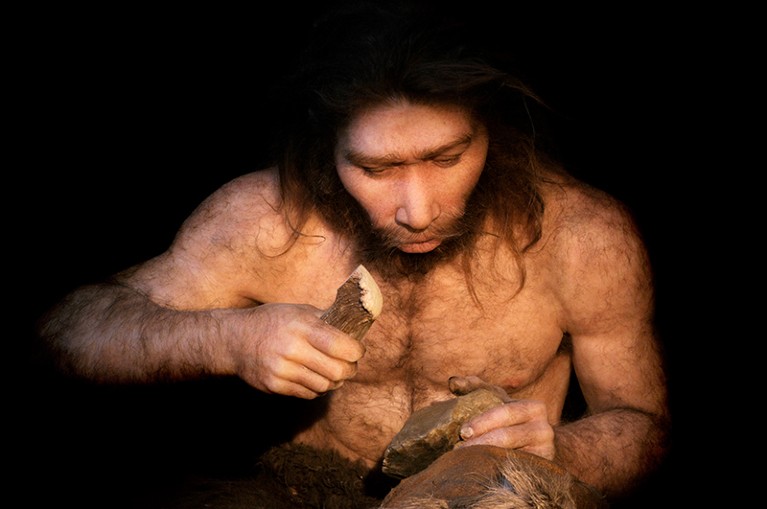As Close to Primal Humans as Distant Cousins
"It makes them much more human, being able to actually show this. It brings them alive in some ways and allows me to think about them in a much more complex way.""[These people come alive and] almost get faces, which is awesome for me [when, as a paleoanthropologist he has unearthed evidence of a small group of Neanderthals hunting ibex and bison].""If you dressed up a Neanderthal in modern clothes and put him on the subway you might think he's kind of an ugly guy, but you would recognize him as just like us."Bence Viola, paleoanthropologist, University of Toronto
 |
| A reconstruction of a Neanderthal father and his daughter is seen in this undated handout photo provided by the Max Planck Institute for Evolutionary Anthropology in Leipzig, Germany. Tom Bjorklund/Max Planck Institute for Evolutionary Anthropology/Handout via REUTERS |
University
of Toronto paleoanthropologist Bence Viola was in distinguished
company, along with his colleague Svante Paabo, winner of the 2022 Nobel
Prize in Physiology or Medicine for discoveries on the genomes of
extinct hominins particularly Neanderthals, and human evolution.
Alongside post-doctoral researcher Laurits Skov at the Max Planck
Institute for Evolutionary Anthropology in Leipzig, Germany when they
joined their academic archaeological skills in the Altai Mountains of
Siberia.
They
discovered a 'milk tooth' of a young girl and the vertebrae and ulna of
her father, in a cave . DNA linked the two, mitochondrial DNA
difference indicating the likelihood they were father and daughter whose
remains were over 50,000 years old. Remains from other Neanderthals of
the 13 specimens the research team focused on, indicated that the males
were closely genetically related, more so than the females.Two males
were found to be close maternal cousins of the father, linked by a
grandmother.
 |
Neanderthals might have lived in small groups, with females regularly arriving and leaving .Credit: S. Plailly/E. Daynes/SPL |
The
research team drew the conclusion that young Neanderthal women and not
young men were those who migrated between different social groups
numbering, they felt, two dozen individuals. The team studied 13
individual Neanderthals making the group the largest studied ever of a
Neanderthal population. It is viewed as unsurprising that people who
lived together and died in close proximity would have been related.
The
adolescent Neanderthal girl whose milk tooth identified her, it was
surmised, accompanied her father on a hunting trip, and the cave where
their remains were discovered was most likely a short-term hunting camp.
The small group would have butchered their game stalked in the hills
and passing by in herds through a narrow valley below.
Neanderthal
remains were first discovered and identified 200 years ago. More is now
known about Neanderthals, revealed over the past 20 years, due in part
to Svante Paabo's genomic research. Where once people thought of
Neanderthals as brutes more akin to wild animals than the animals that
were humans, it is now known that they were sufficiently advanced to
produce art, music and language, as well as fashioning rude tools. The
patterns of their social lives appear now to be similar to that of homo
sapiens.
The
13 Neanderthal remains being studied came mostly from Chagyrskaya Cave,
with two from the Okladnikov Cave, both considered to have been
short-term hunting camps. Located in southern Siberia's Altai Mountains,
the sites are as far east as Neanderthals are known to have located
themselves. Evidence from a major Neanderthal site, the Vindija Cave in
Croatia, appears to point out that Neanderthal populations in Europe
may have been different.
"Our findings raise questions as to whether the characteristics of the Altai communities are related to their isolated geographical location at the easternmost extremity of the known range of Neanderthals ... or whether they are characteristic of Neanderthal communities more broadly."Research study, published in Nature
 |
| Chagyrskaya Cave, located in the Altai Mountains of southern Siberia in Russia, s seen in this undated handout photo provided by the Max Planck Institute for Evolutionary Anthropology in Leipzig, Germany. Scientists have sequenced the genomes of 11 Neanderthal individuals based on remains found in the cave. Bence Viola/Handout via REUTERS |
Labels: Neanderthals, Paleoarchaeology
Labels: Neanderthals, Paleoarchaeology

<< Home